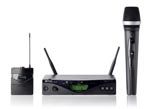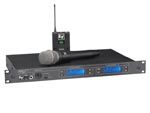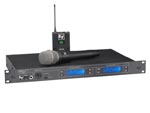- The proliferation of 802.11-be it a, b, g, or n-has resulted in increased wireless traffic in practically every facility, whether it's a business, church, or auditorium. This is especially true for the 802.11b and g spaces, which operate in the 2.4 GHz frequency band.
- Given the crowded nature of the 2.4 GHz neighborhood, the integration of wireless devices into a audiovisual system requires similar technical considerations to those employed in IP networks, noted Matt Nelson, director of marketing at Avocent. "Whenever you put any device on an IP network, it needs some sort of management, because you have to understand how much bandwidth it's going to require, what it's going to do, and how it's going to interact with the environment," he explained. Consequently, "for any wireless device that you add to the environment, you've got to understand if it's going to take more bandwidth than some other device."
- This dictates the need for an RF survey, which takes into consideration a facility's RF environment, including how far and where RF signals are reaching. It also accounts for what materials are inside the building; for example, RF signals don't transmit through metal, however they have no problem traveling through gypsum walls.
- "When you look at a location, there are a lot of construction materials that have different effects on a wireless signal," said Scott Carpenter, product manager at AMX. "If the facility has a lot of concrete with rebar, you are not going to be able to penetrate those walls in the same way than if it was just wood and sheetrock." In the former case, setting up access points every 50 to 100 feet will not suffice. "You really need to map out the wireless coverage," Carpenter emphasized. "When you do that, you can identify where you might have bad spots."
- Interference being a significant issue in the 2.4 GHz space, a site survey should include a mapping out of channel allocation to determine which access points can be placed on channels 1, 6, or 11. Carpenter notes that AMX provides online training that covers how to conduct wireless site surveys in conjunction with the development of a channel re-use plan.
- Rich Sasson, director of technical services at Crestron Electronics in Rockleigh, NJ, suggests that contractors use a WiFi Spy key (a USB device) or Net Stumbler, a free, downloadable program. "This will allow them to take a snapshot of the environment that they are going to install a system into," he elaborated. "It goes back to doing the basics before you even get started: analyze the facility and verify what channels of RF are being used, and what are the best channels to put products onto." Crestron offers an RF map online, and holds two-day configuration courses, part of which cover setting up access points and routers, and conducting a WiFi analysis.
- Moving beyond the control realm to the process of integrating wireless projectors onto a network, Rich McPherson, product manager at NEC Display Solutions acknowledges that contractors face some challenges. "If they put it on the network using DHCP, then the network assigns an IP address to the projector," he said. "If, by chance, it loses the connection and that IP address changes, anybody trying to connect to the projector no longer knows the IP address." Assigning static IP addresses is a solution, however the more projectors there are, the larger the network must be to accommodate for them. McPherson adds that NEC's sales team and technical instructors are available to walk dealers through this process.
- While audio and data have been distributed wirelessly for a number of years, wireless video continues to remain the last frontier. "Presently, even though there is 802.11a, b, g, or n-and typically, projectors are stopping at g at this moment-it's not a feature that you actually transmit to video," McPherson said. "At the moment, there is not that capability built into the product. Realistically, it's for PowerPoint or sending Excel spreadsheets. It's more for presentation than it is for live video."
- Nelson, however, points out that Avocent is in its fourth generation of wireless video. Earlier this year, the manufacturer announced the introduction of its Emerge MPW extender, which delivers high definition (HD) content from a single source to multiple destinations. "A lot of integrators don't know that there are wireless video distribution systems like what Avocent provides," he said. "Avocent can distribute up to a 1080i, 720p resolution, very good quality, consistent graphics from a signal source multiple destinations." He adds that the company's devices employ the 5 GHz 802.11a standard, in part to avoid the network traffic that is associated with those on the 2.4 GHz band. "If you do something like that, where you have your specialty devices operating at a totally different frequency, you know that they are not going to interfere with one another, and that they will all behave well in the same space."
Wireless Microphones
beyerdynamic Opus 900
The new Opus 900 system benefits from the experience with the Opus 500 Mk II and 800 systems. Opus 900 was designed to meet the rigorous operating criteria of multi-channel systems for professional applications. Two new transmitters are available, with metal housing or durable plastic housing with charging contacts on the base. Both models feature color-LCD display, automatic frequency scan, and setting function. The Opus 900 system offers a range of interchangeable capsules, enabling a full range of uses, handling theater, broadcast, large installations, or live concerts.
Azden IR-CS Infrared Classroom System
In today's RF saturated world, a regular microphone system risks interference from a variety of other devices and sources. Although you can purchase components separately to customize your own system, Azden provides two complete systems (IR-CS and IR-WS) which include: an IR receiver with ample power for four ceiling or four wall-mounted speakers and a built-in sensor array, a small, lightweight chest-worn microphone/transmitter, a pass-around handheld microphone/transmitter, an external ceiling-mounted sensor, and four high-quality speakers. All you need to complete the installation is the wiring for the speakers and sensor.

Shure UHF-R Wireless
Shure Incorporated's UHF-R wireless offers superior RF performance and rock-solid reliability, as well as control even in large, networked systems. With 2,400 selectable frequencies across a 60 MHz bandwidth, UHF-R allows up to 40 preset compatible systems to be operated per band. Up to 108 systems can be put to work using multiple bands. Complementing this expanded window of operation is Shure's Advanced Track Tuning Filtering Technology, which shifts onboard RF filtering within selected frequencies to maximize both compatibility and isolation from interference.
TOA S5 Series
TOA Electronics introduced its latest professional grade wireless microphone system, the S5.5. Available in two configurations, handheld or belt pack/lapel, the Trantec S5 Series is designed by BBM Electronics Group and is ideal for a wide range of applications including houses of worship, hospitality, colleges and universities, rental, and performing arts venues. The range and audibility of the microphone units have been enhanced with improved antenna and pick-up circuitry, and utilizing true diversity, up to 24 microphones can be deployed in the same venue without interference.

AKG WMS 450
AKG Acoustics' WMS 450 wireless system offers a cost-efficient, high-performance solution perfect for performances at small clubs and stages, as well as for local or traveling events. The system combines the SR 450 stationary receiver with the HT 450 handheld transmitter and/or PT 450 pocket transmitter. The SR 450 provides the widest frequency range and highest S/N ratio in its class. The HT 450 handheld transmitter comes in D5 or C5 microphone versions, with a spring steel elastic wire mesh cap for safe protection of the capsule element.

Sennheiser MKH 5200 Wireless Transmitter
Rugged, reliable and user-friendly, the SKM 5200 may be paired with a choice of six Sennheiser and two Neumann interchangeable microphone heads to accommodate any stage, broadcast, and recording situation. The choices include five condensers and one dynamic, with omni-directional, cardioid, wide cardioid, or super-cardioid pick-up patterns. Sensitivity can be switched in 1 dB steps to adapt to any recording situation. Further, Sennheiser's HiDyn plus noise reduction system reduces RF noise to an absolute minimum, ensuring wide dynamics and crystal-clear sound. With easy frequency selection, the SKM 5200 offers two channel banks, one fixed, and one variable.

Electro-Voice RE-2 UHF Wireless
The RE-2 Series wireless microphone system brings sophisticated professional features to an affordable price point. The RE-2 is a completely programmable, frequency agile system with one-touch Auto-ClearScan, operation over 28MHz, XLR mic or line level outputs, and many other features. The BPU-2 compact bodypack transmitter for the RE-2 is made from high impact ABS plastic. The single on/off switch also functions as a mute and the TA4 microphone connector is compatible with any of the EV lapel and headworn microphones, including the new RE97Tx.
Audix Headset HT5
The HT-5 is an omni directional headset microphone designed for fidelity, functionality, and durability. The versatility of the HT-5 allows it to be used for a wide variety of applications. The omni-directional headset maintains high speech intelligibility without sounding hollow or harsh while the low profile design focuses the attention of the listener on the speaker not the microphone. The HT-5 includes a flexible steel frame that is adjustable for different head sizes. Additionally, the flexible micro-boom also permits the element to be positioned by the user for sound quality and comfort.

Avlex MIPRO ACT-707 Quad Wireless System
The MIPRO ACT-707 Quad Wireless System incorporates MIPRO's exclusive Automatic Channel Targeting function for error and interference-free system setup, a multi-status color LCD panel display, and upwards of four hot-swappable receiver modules that can be controlled via a PC. Featuring a built-in four channel antenna divider, worldwide voltage switching power supply, and four channel independent or mixed outputs, the four channel modules occupy only one unit rack frame-saving both space and installation time. The system consists of the ACT-707F receiver mainframe, the ACT-707MC receiver modules, the ACT-707HM handheld microphone transmitters, and the ACT-707TM bodypack transmitters.
Audio-Technica AT892cW Microset Headworn Mic
Audio-Technica released a series of new bundles featuring the Audio-Technica AT892cW MicroSet headworn microphone with the A-T 2000 and 3000 Series wireless systems. These bundles offer a cost-effective, all-in-one, turnkey solution for wireless needs, making them ideal for house of worship, educational, and commercial scenarios. Intended for a wide range of applications, the AT892cW subminiature headworn condenser microphone combines maximum audio quality, minimum visibility and a unique, comfortable under-ear design. Featuring miniaturization technology, the AT892cW utilizes a condenser capsule with a diameter of a mere 2.5 mm, making it ideal for low-profile applications.

Lectrosonics VRM WB Wideband Receiver
The Lectrosonics VRM WB wideband receiver employs the company's digital hybrid wireless technology and covers the entire UHF band from 537 to 768 MHz in a single unit. It is compatible with any Lectrosonics VRS standard module or VRT tracking filtered module in the standard UHF range. The unit offers a modular configuration that enables users to install any combination of Lectrosonics' standard fixed bandwidth receiver modules as well as VRT tracking filtered modules for a total of six channels. The receiver supports three diversity modes: phase switched, ratio, and frequency.
OWI CRS-101 Infrared Wireless
OWI launched the CRS-101 infrared wireless microphone system. The CRS 101 microphone system is ideal for classrooms, boardrooms, training rooms, and hotel meeting rooms. The slim, fully lockable, wall mounted, infrared receiver/amplifier/mixer accepts three different line level inputs. Because the CRS-101 is wall-mounted, there are no freestanding or rack-mounted components to take up closet space or be knocked off a shelf, and no unsightly tangle of wires. The CRS-101 system can simultaneously control two included infrared wireless microphones.










